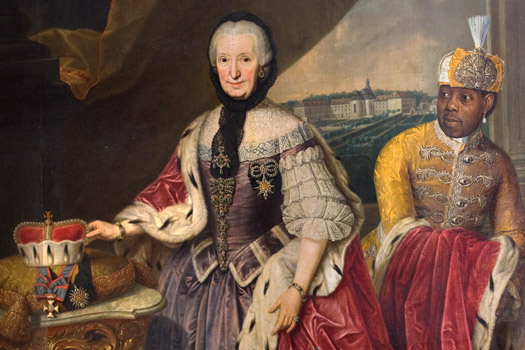
Fürstäbtissinnen regieren Essen
Nur Frauen aus den höchsten Kreisen des deutschen Adels wurden in das Stift Essen aufgenommen. Sie kamen oft von weit her und brachten ihre eigenen, „fremden“ Erfahrungen und Vorstellungen mit, die sich auch in den erhaltenen Bauten widerspiegeln. Anders als in einem Kloster legte keine der Damen ein Gelübde ab. Sie besaßen Häuser, hatten Kammermohren und eigenes Personal, konnten reisen und auch jederzeit das Stift wieder verlassen, um zu heiraten.
© Fürstin-Franziska-Christine-Stiftung Essen
Herrschaft zurück zur Auswahl
Power in the hands of Women Princess-Abbesses rule Essen
Until secularization in 1803, the small spiritual principality of Essen (in terms of spatial size, almost equivalent to today's city) was ruled by women for nearly 1000 years. Some of the more than 50 principality abbesses ruled this imperial abbey for 30 years or longer. Not only they but also the nuns practiced their dominion over their subjects in Essen. Only women from the highest circles of German nobility were accepted. In contrast to a monastery, none of the women had to take vows. They owned their own houses, had their own staff, could travel, and leave the abbey at any time to marry.
The women often came from far away – from the Netherlands, Bavaria, Thuringia, Saxony, Austria and Switzerland. They brought their individual “foreign” experiences and expectations with them, which are also reflected in the preserved buildings.
Near the Abbey in Essen (located in today’s city center, next to the Münster), the castle in Borbeck (today a part of the city Essen) served for centuries as a residence for these rulers. In the 18th century master masons from Liege (Soiron), Maastricht (Lousberg) and Brabant (Duker) gave the castle the character it retains today.
Surrounded by water, it is located in the middle of a generous historical park in the north of Essen. Until long into the 17th century, this castle was a residence of the prince-abbesses, in wartimes it was however also a refuge for common people. After the Thirty Years War, Anna Salome von Salm-Reifferscheidt, born in the Castle Dyck near Neuss, had the completely destroyed site rebuilt from scratch. Castle Dyck is said to have been used as a model for this reconstruction.
The princess Abbess Franziska Christine (1726-1776) founded an orphanage for the Essen Abbey Region and had an abbey building built near Steele for that purpose. From the beginning, this private trust was intended to fulfil three functions: a station for a new Jesuit mission on the border of the protestant County of Mark; an orphanage to compete with the protestant orphanage of the city of Essen which had been existence since 1728, and as a residence for the princess because the abbey buildings in Essen were in quite bad condition. The Princess Franziska Christine Foundation today is a private foundation under public law, run by a board of trustees.
Denkmale zum Impuls
Essen - Grabmal des Ignatius Fortuna in der Kapelle der Fürstin-Franziska-Christine-Stiftung
Spätestens seit der Mitte des 17. Jahrhunderts hatte jeder Fürstenhof, der etwas auf ... weiter
Essen - Schloss Borbeck
Nahezu 1000 Jahre lang wurde das kleine geistliche Fürstentum Essen von Frauen regiert. ... weiter
Essen - Fürstin-Christine-Stiftung in Essen
Für die Waisenkinder des Essener Stiftsgebiets.gründete Fürstäbtissin ... weiter

